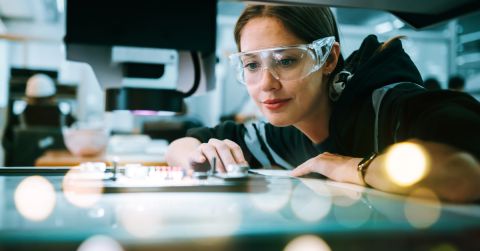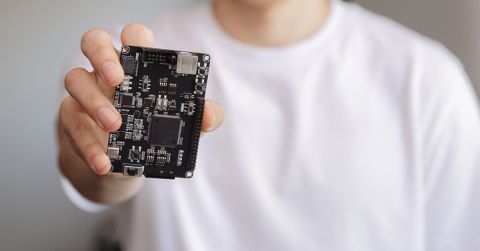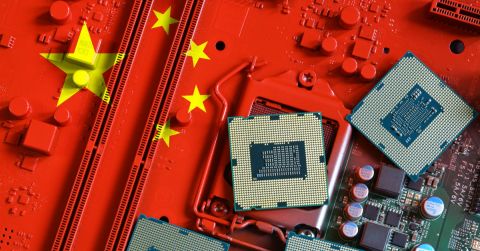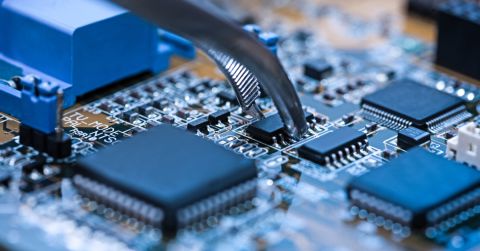The Evolution of Robotics at MassRobotics

Dive into the fascinating world of robotics with MassRobotics, an independent nonprofit organization dedicated to advancing the robotics industry. Located in the heart of Boston, Massachusetts, MassRobotics plays a crucial role in supporting startups and driving innovation.
In this episode of the CTRL+Listen Podcast, hosts James and Joseph explore the evolution of robotics at MassRobotics with Thomas Ryden to discover how it has become a leading hub for technology and innovation. Discover the unique programs and resources offered, including a full machine shop, CAD software, and networking opportunities with industry leaders.
Listen to the Episode:
Watch the Episode:
Episode Highlights:
- The origin story and mission of MassRobotics
- Key differences between innovation centers and incubators
- The impact of MassRobotics on startups and the community
- Exciting resident companies and their groundbreaking projects
- How MassRobotics connects startups with investors and partners
Links:
Find out more about MassRobotics here
Connect with Tom Ryden here
Transcript:
James: Hi everyone, this is James from the Ctrl+Listen Podcast brought to you by Octopart. I'm joined once again by my co-host, Joseph Passmore. Today we have Thomas Ryden, the Executive Director of a really fascinating entity operating out of Boston, Massachusetts. Thank you so much for coming on the show. Really looking forward to learning more about what you're doing here today.
Thomas: Great. Well, thank you for having me.
James: Do you wanna tell us a little bit about MassRobotics? Sort of the origin story and the mission of the organization?
Thomas: Sure. So, MassRobotics is an independent nonprofit organization. Our mission is to support the robotics industry as a whole, and particularly, to help startups be able to succeed. And we do that in a number of different ways. I can go into that in a little bit more detail, but we got started about eight years ago when there was a recognition by some folks from the industry that a lot of technology was being developed at universities in the area, particularly MIT, and that startups weren't staying here or were having difficulties being successful. And part of that is because, if you know robots, it takes a long time to develop a robot. It takes a lot of resources. And so you need to either raise some significant funding or have a good kind of pathway to be able to be successful. And so that was struggling, a number of struggles for companies. And we decided to form MassRobotics to really help address those early stage startups and provide them with the resources that hopefully will allow them to have a longer runway and be successful.
James: Fantastic.
Joseph: What else are the key differences between an innovation center and say an incubator?
Thomas: Yeah, that's a great question. We actually run an accelerator as well, but we're not a traditionally an accelerator, an incubator. We're, kind of the way to think about us is like a shared workspace, like a WeWork, but with a lot more resources. So we provide space, physical space, for our startups if they need that. But in addition to space, we provide a lot of the tools and resources that startups may need to develop a hardware product. So, specifically on the prototyping side, we have a full machine shop, laser cutter, water jet cutter, 3D printers, all of that so people can build their own hardware. And we also have a lot of resources that will help them do that, particularly software. And I think that's one of the great things that we can provide our startups. CAD software, or Altium, and other packages that companies will find useful and sometimes are expensive for a startup to get when they're just getting going. I think the other major thing that we do for our startups in supporting them is provide them networking connections and I don't mean the physical networking, but really connections to partners, suppliers, potential customers, potential funders, that type of thing. We do a lot of events and programming to support the startups in that way.
James: Are there any sort of minimum requirements for a startup looking to partner with you?
Thomas: Yeah, so startups have to apply to get into MassRobotics. And since we don't provide funding and we don't really, we don't take equity at all, we have different requirements than maybe if you're looking to get funding from a VC. We do wanna understand what you're doing in terms of your business, but we also are more interested in the impact it will have on the robotics community, how you can contribute back to the community, what you're developing will be impactful and useful in the robotics community. Then of course, we look at traditional things like what is your market that you're going after, what's the team, who's members of your company? So we do have some of the traditional, you know, fundraising questions that we ask, but more of it's around the community and how you're gonna contribute to the community.
Joseph: And apart from the tools that are provided, how do you help your residents achieve their goals?
Thomas: Yeah, so a lot of what we do is running educational events and networking events to help the startups. So for instance, twice a year, we run our demo day for our investors and we work with about 35 or 40 VCs in the area. And we invite them in twice a year to our facility to meet our startups, select some of our startups. We select usually about 20 of them, and they present to the VCs that come. But it's more of an informal, it's not like a traditional pitch session, it's more of an open house where they can come and meet investors. And so we do that. We do very deep dives in technology. We have visiting speakers, usually professors from different universities come in and talk about topics. Sometimes we have our partners go into deep dives on technical things around maybe SLAM or navigation or things that, or sensors, or in many of the cases on the hardware side, what is the semiconductor technology that they are looking to implement, and is there ways that we can provide them more education around some of that?
James: Are there any particular residents that you'd wanna mention? Just some of the ones people might find interesting?
Thomas: That's a tough question. You know, we love all of our residents. And so, you know, I think what's really interesting, we have just over 80 companies here in our facility. They're all doing something in the hardware robotics area, but they all are working in different markets, which I think makes it really interesting. One of the newer companies is a company called Crabby, and they are doing robotic hull cleaning. So cleaning the debris off of hulls so that they're more efficient as they move through the water. We have another company called Robot that is doing the analysis of crops using a robot that can go through the fields and look at crops like corn and so forth. And by automating some of these tasks, there's so many things that you can improve on, whether it's actually just getting rid of the weeds or adding pesticides or fertilizers or things like that, you can do that more efficiently with robotics. So we have a number of companies that are in the ag tech space that are doing that. We have companies in construction, we have companies that are doing, of course, warehouse automation, probably the most popular area right now of robotics. And then certainly manufacturing, one of our biggest areas.
James: That makes sense. Yeah, those two in particular are massive right now.
Thomas: They are, and that's where we're seeing a lot of investment, and specifically on ways to make robots, collaborative robots, more efficient and more flexible so that they can be used in small and mid-sized manufacturers, and they can be used to do more and different tasks. So, both the arms themselves and then the end effectors, or the grippers to be able to pick up more objects. And then of course, the vision and intelligence to be able to do something with those parts, whether it's place them in a machine, whether it's do something on the assembly process, all of those applications are really popular amongst a number of our companies right now.
James: Yeah, I've actually been following both of those spaces, the grabbers and the vision stuff. It's crazy how fast that's advancing.
Thomas: Yeah, I think, you know, it's funny just even, when you look at grippers, it's pretty specific, right? And you might think that's a small market, but it's actually pretty large. There are a few dominant players in there, but then there are a number of companies that are coming up with different ways, whether it's soft grippers or flexible grippers or different types of vacuum grippers. One of the areas that I'm really excited about is companies doing variable size grippers. So, you know, if you're a large scale manufacturer and you're doing a particular part and you want to pick that part up and it's generally the same size, great, you don't need that. But if you're a small manufacturer that maybe is picking up one size and then tomorrow something that's maybe twice as big, having a gripper that can actually almost shape shift and pick up different size objects is really interesting. And so we have a couple companies working on that.
James: Yeah, I've noticed as well a growing trend in like, a plug and play sort of attachment. So, maybe just switch out arms easily.
Thomas: Yep, exactly. So, both on the arms and the end effectors. So the ability for you to pick a tool that you really need for the task, and whether it's a larger or smaller arm, whether it's a different gripper, and be able to rapidly plug those in with limited programming is really helpful for a lot of manufacturers.
Joseph: I understand that you have sponsors. Could you tell us a little bit about how that works?
Thomas: Yes, as a nonprofit, we get the majority of our funding from our sponsors. And our sponsors are generally in the robotics field. They make things such as motors like Maxon or gears like Harmonic Drive, or they provide the semiconductor technology that runs a lot of the robots, companies like AMD and Lattice Semiconductor and Analog Devices. So a lot of them have the components to the robotics, and then there are others who are actually looking to use robotics and want to understand the field and where it's going. And so they sponsor us to really get that early look into what's happening in this field.
James: Are all of your partners based out of Massachusetts or are they spread sort of all over the US, or even internationally?
Thomas: Yeah, it's interesting there, it's international. We have a number of great partners out of Germany like Festo and Japan. So, we really draw from around the world. It's really who's doing something interesting in robotics that is looking to work with startups and help them as they go on their journey. So, a lot of our partners are very committed to both, obviously providing their parts and their expertise, but also just helping the startups and giving them advice as they try to, you know, as the startups trying to learn about the business.
James: That's great. It's such a competitive space. It's so hard for people to figure out what the next steps are. So, great that you're there for them.
Thomas: Right. And then some of our sponsors are large customers in themselves, and so their ability to kind of share with the startups what they're going to be needing in the future, and that helps drive some of the development that our startups are looking at. It's always great to be able to work with maybe a Fortune 500 company and understand what their problems are and the scale of the problems. So sometimes startups are very focused on trying to come up with a solution but don't necessarily understand exactly how that solution is gonna work in a large factory, like a P&G, or a FedEx, or somebody like that. And we work to try to get them insights into some of those larger companies.
James: It almost feels like a company equivalent of a mentorship in some way, then.
Thomas: Right. Yep. Yeah, and it's great to have some of the community give back and be mentors to some of the startups, so that's an exciting part of what we do. We also run a traditional accelerator. So, we run a 13-week accelerator where the companies get a hundred thousand dollars of no equity funding and then 13 weeks of programming and then they get dedicated mentors assigned to them through part of that. And so that program once runs once a year. We're opening up applications in the middle of August for that.
James: Fantastic.
Joseph: Apart from the proximity to the university, are there other advantages of being based in Boston?
Thomas: Yeah, so you hit on one of the key things. There's so many universities here and there's so much technical development going on in the area. It is great. And a lot of the universities we work with very closely and the professors are here and they'll come over and either, as I said, give talks or work with the startups. So, there's about 36 robotics labs almost walking distance of our facility. You know, MIT has about six or eight themselves, but we have, you know, BU, Northeastern, Tufts, Harvard, and it's all great to see that development. But beyond that, there's a lot of other support that Boston can offer. Because there is so much technology that's being developed here, there's a lot of support infrastructure around, and that's everything from like lawyers who understand how to work with VCs, of course, the VCs, and other service providers that do that. And then also in Boston and well, outside of Boston, we have some manufacturers who work directly with a number of our robotics startups and build their products here. And we're excited, like Amazon Robotics for instance, one of the largest providers of warehouse automation to Amazon, obviously, but they build all of their platforms here in Massachusetts. So, having that knowledge, having some of the contract manufacturers that know how to build these mobile autonomous systems in the state is very helpful.
James: I imagine it's also quite a bit more affordable there than Silicon Valley.
Thomas: I don't know about that. Boston's still pretty expensive. It is. I mean, I think it's a little bit cheaper, but I think the neat thing about Boston is it is also a smaller community. So, in many respects it's better connected, I think than other ecosystems. It still has that small town feel, so we think that's really beneficial.
James: I heard that you've hit an impressive milestone recently. Did you want to tell us a little bit more about what that was?
Thomas: Yeah, so one of the things we track with the companies we work with is, well, there's two major metrics that we track. One is the size, so physically how many employees they have and so forth. And then the other is how much fundraising they have done and how successful have they been in raising outside capital, primarily VC capital. And so we just hit, for our startups, they've raised over $1 billion. And so for us that's a major milestone. It also indicates the success that the companies are having and that's outside funding from VCs primarily or other investors. They've also been very successful in getting government grants. So, we have a number that have SBIRs, or other grants from NSF and other locations, but that billion dollars is not including that amount of money, it's just truly the outside funding that they've raised.
James: Congratulations. That is excellent.
Thomas: Thank you. Yeah, I know, we're really excited about that. So.
Joseph: How is robotics impacting the manufacturing and supply chain sectors? We talked a bit about warehouse.
Thomas: I think robotics is gonna continue to grow in its impact on both supply chain and manufacturing. I think in supply chain over the last couple of years, we've just seen the rapid growth of robots within the warehouse moving goods, but there's still many challenges ahead, especially in mobile manipulation. So the ability to have a robot that picks and moves the goods out to a pack-out area. And we're seeing a lot of development on that. People are really focused on being able to pick almost any object and help somebody package it and ship it. And I think that's a great area of growth. But we're seeing other areas that people are using robots within the warehouse, everything from inspection, inventory counting, and then simple things like cleaning and just automating all sorts of different movements of goods. We're seeing the same thing kind of in manufacturing where we're seeing essentially the growth of collaborative robots. So, robots that are human safe that you can work around. It's a really interesting area because I think there are so many tasks in a manufacturing floor that will be very challenging to fully automate, but parts of those tasks can be automated, and the ability to have a collaborative robot working side by side a human, and maybe doing or two of the tasks while the human does some of the tasks and that cooperation is really gonna make both the human more impactful and effective in their job, but also the automation more productive and a quicker ROI. So that's one of the areas that we are really excited about.
James: Fantastic. Something I just thought of, would you say the genie's sort of out of the bottle with robotics now? Is this just gonna be the new norm? A no going back sort of situation?
Thomas: Yeah, I think so. It really is, you know, it's kind of almost in some respects in some of the markets, it's the fear of missing out, right? They're starting to see a lot of their competitors add automation. They're recognizing that whether the company can more effectively produce goods or service customers through the use of automation, and they realize, oh, we need to get on board and start to do that. So, we just signed a partnership with a company called Chewy, Chewy.com.
James: I know Chewy. Yeah.
Thomas: You know Chewy? Yeah, you know, a lot of people know Chewy. They ship an amazing amount of goods, from pet foods and so forth, and they're looking to continue to automate to make it more effective for them to ship and deliver in a timely fashion. And there's some things that they automate really well, but there's others that they're still having challenges of. And think of the variety of, if you order like, dog food in bags or all that stuff, things that are in different packaging that might be hard, they're looking to automate the movement of all of those goods, and I think robots is just a perfect way. Not only that, you know, dog food can be pretty heavy, or cat litter in a pail can be pretty heavy. And that's not necessarily a good thing to have humans lift and move all the time. So again, what can we do to have robots automate some of that? And we're excited to work with them on some challenges and seeing how robots can be used more efficiently in some of their locations.
James: Really interesting. I think for them it makes sense because they obviously have the business side, but the thing that really makes them stand out as a company in my opinion, is they have a really nice personal touch that they go above and beyond with their clients. So automating the warehouse space will give them more time to focus on that. Joseph, I don't know if you know Chewy, but they really go like, above and beyond. For instance, like my dog's birthday passed recently and they sent me a painting of him that they had created.
Joseph: That is above and beyond.
James: Yeah. Like, things like that.
Thomas: And I think that's what really makes them stand out. Yeah.
James: Yeah, my mother-in-law's dog passed away and they sent her a bouquet of flowers. Like, you know, things like that. It's very unusual to see something like that.
Joseph: Yeah. What other industries has robotics been revolutionizing?
Thomas: Yeah, I think that's the really exciting thing for me is seeing all the different industries that can be impacted by robotics. There's really hardly any that this technology won't be able to change in the future. The areas that we're seeing a lot of kind of development and traction in are certainly agriculture, I mentioned that already. I think everything from indoor farming to really in field inspection and the more efficient use of fertilizers and pesticides, all of that I think can really be beneficial, you know, benefited by robotics. Beyond that, I think healthcare is an interesting area that we're seeing a lot of development on, both on assistive technology, so wearable robots, robots that can help you maybe recover from a stroke, retrain, or provide you mobility if you've lost mobility in some fashion. So, kind of the exoskeletons. We're certainly not anywhere close to what the movies show, and you know, Iron Man is great, but yeah, we're not there. But the development's come a long way and it's amazing how much lighter and more efficient these wearables are. So, the batteries last longer, so they can help maybe even a worker in a warehouse lift goods for almost all day on a single battery charge. I think that's an interesting area. But even longer term, kind of helping the elderly remain in their homes longer and having robots assist both in them moving and mobility in the home, but also in just things of daily living, grabbing items, getting items, and so forth. That's an area that there's a lot of development going on, and you know, as I'm getting older, and you can probably tell by my gray beard if you look at me, I'm on the later stage of my career. So having some of that technology being developed I think is really exciting for me.
Joseph: Sort of power armor for pensioners.
James: Love that.
Thomas: Great idea.
James: Love that. So, a question I thought of as well while we were talking, if you don't know the answer, that's totally fine. I'm just curious, are you aware of any differences in the way robotics are being developed and manufactured in the US versus Europe?
Thomas: Not necessarily in Europe, I think what's interesting though, like in Japan, we do a lot of work throughout the world. There's a few countries that we specifically work very closely with, Japan being one of them. Korea, Singapore, we do a lot in Europe. I think it's interesting how different countries have different focuses on what they're developing. And I think like in Japan, obviously factory automation is a big part, but also they have much more interest in human companion robots. So robots like social robots, I think that's further advanced in Japan than it is here in the US. And I think like in Korea, there's a emphasis on home robots, and they're doing some interesting things in that area that, you know, we're looking at. So, I think different countries have different focuses and that's based on the needs that they have by their society and what they see. Certainly Germany is really far advanced in automation and continues to really be focused on that area. And that makes sense. They have a lot of manufacturing there and they have the knowledge base. Some of the industrial robots were first designed and really deployed in volume in Germany. And so, I think that's going to continue to be a strength of theirs, although we're seeing China do a lot, in fact, in virtually every area, but certainly in manufacturing automation. China is certainly doing quite a bit of installations and development of that technology.
James: That makes a lot of sense.
Joseph: Are there any other innovations in the robotic space that people should be keeping an eye on?
Thomas: Certainly, I think there's no question that AI is impacting everything, and robotics is no different. Robots have used AI for a long time, machine learning and so forth. But I think some of the work that's done in LLMs and LVMs really can impact the ability for robots to understand new tasks and pick up new tasks without being fully programmed in the traditional manner. And I think that's just gonna help in the deployment, especially we talked about around the home, right? Nobody really wants to have to program that robot. If they're sitting at home and say, go get a cup of coffee, they just wanna tell the robot that. And so I think a lot of the natural language processing, the ability for you to communicate to the robots in a much more natural sense and have them understand when you tell them to do that task without going into deep detail but just basically saying, go empty the dishwasher, and then having them understand that at a level that they know what to grab and where to put it and all of that. I think that's gonna be interesting. We're certainly a few years away from that, but in many respects it's coming quicker than self-driving cars. So, we always joke about self-driving cars seems to be about five years away, and it has been for the last 20 years.
James: Yeah. One last question before we wrap things up. There's a lot of fear out there of robots and robotics in general, automation replacing people's jobs. Is that a fear that's unfounded or is there some truth to it? Or do you think it's somewhere in the middle where it's gonna be more of a repurposing of jobs or retraining of jobs than a loss of jobs?
Thomas: Yeah, I really believe that it is in the middle. It is going to be a repurposing of jobs. I think there are a lot of tasks that people do today that not necessarily want to do. You know, we talk about the three D's, the dull, the dirty, and the dangerous, and a lot of tasks and jobs fall in that range and I think robots can assist. But as I talked about earlier, robots don't have the ability today, and I don't think for a long time, to fully take over the jobs that we do. They don't have the reasoning skills and the ability to adapt to changing environments in the way that humans do. So there's always gonna be a role for humans and I think that that kind of working together is gonna be really the sweet spot that is really going to help society in many ways. So yeah, I think this fear of robots taking jobs is certainly unwarranted. It is going to change the nature of the jobs, but yeah, I don't think we've seen massive displacement by robots anytime soon.
James: Do you think it's more of a matter of viewing robots as a tool or something that will assist you as opposed to replace you?
Thomas: Yeah, I think really, they are a tool, and in many respects as we learn more about them and become more accustomed to robots, we'll see them more as that tool, right? In many respects it's like if you think about a self-driving vehicle or even just a standard vehicle, there's a lot of what we consider robotics in a vehicle today. Automatic braking is a robotic sensor type of system and yet most people wouldn't buy a car without ABS. Right? You become accustomed to that technology being able to help you drive more safely in a car. I think that's gonna be the same thing. They'll be viewed as tools, they'll be used in many different areas and you know, in the future you'll be going into a factory and go, what do you mean you don't have a robot to do that? Why am I sticking my hand in that oven, right? There should be a safer way to do this, and I think that's what we're gonna see.
James: Do you think it's a little bit a matter of the rate at which technology's advancing that people sort of haven't had time to become comfortable with it yet? Because honestly I think back maybe two years ago, three years ago, and the robotics discussion was sort of theoretical, and now in the last few years it's become very practical.
Thomas: Yeah, I think the rate of adoption is definitely increasing. And so you're going to see a lot more robots in many different areas, and you're gonna start to see them in public applications a lot more too. So then people will become more comfortable. And whether it's a robot at a restaurant just delivering some food, you know, the more people see of them, the more they'll get comfortable with them. And as you said, I think the more that they'll accept them and imagine other opportunities to use them.
James: Yeah, it's like people now looking at their smartphones. A few years ago that was such strange technology, but now no one can survive without one basically.
Thomas: Yeah, and just think of all the computational power that is in your pocket. You know, five or 10 years ago, just unheard of that you could have that capability really in such a small package. And I think you're gonna see the same in robots. It will take longer just because of the nature of physically moving in an environment and all those challenges that that brings. But you'll certainly see that same rapid rate of development of robotics.
James: Fantastic. Well, that kind of brings us to the end, but I had one final question for you, which is if people want to sort of keep up with what you're doing, see the companies that are involved with you, stay up to date with new things that you're developing, what's the best place to do that?
Thomas: Ah, we actually run an event every year called RoboBoston, which is a big block party and we bring about somewhere between 15 and a hundred robots out into the public, so to speak. We have some big tents in Downtown Boston and we have a number of our companies bring their robots out, a number of our partners bring their robots out, and it's a chance for the public to interact with the latest technology. And so it's a great time if you are looking, I mean, we have, last year we had self-driving vehicles. We had certainly a number of spots from Boston Dynamics, the robotic dogs. We had some robotic birds. And then of course factory automation and all sorts of other things. So, it's a great opportunity for people to come and just interact with robots and see what's going on. And we also do a lot of educational robots and have them available, so if children wanna play with some of the toys that are robotic enabled, they can do that at this event as well. And that is on September 30th this year in the Seaport District of Boston.
James: Great. Fantastic. Really cool. Wish I could attend that. If people can't make that, is your website a good place to stay updated?
Thomas: Yes, yep. So all of the companies we work with are listed on our website, so it's massrobotics.org. And also a number of our events and what are called challenges are our ways that you can get involved in robotics if you're developing a robot. We run challenges all throughout the year where you can take some of your skills and work on projects that maybe a partner has suggested and it's a great way to get involved in the community. And then, as I said, we do events and many of our events are open to the public. We also do events around the world. We've got some events in California coming up and in Japan. So, all of that can be found on our website.
James: Fantastic. And to connect, is LinkedIn the best place?
Thomas: Yes. Yep.
James: Fantastic. Well, thank you so much for coming on the show. It's been a really fascinating discussion about some issues that are very current and very relevant today.
Thomas: Good. Well, thank you very much for having me.
James: Anytime.
Joseph: Pleasure.
- And for anyone watching, come back next week, we will have another guest for you.








